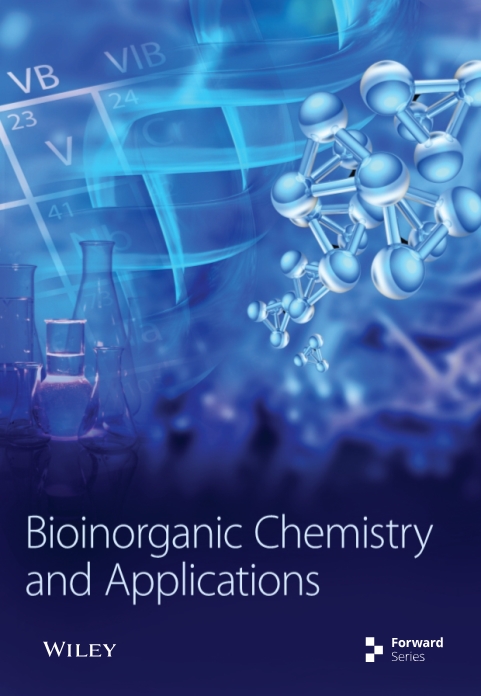带有芳基膦和芳基鏻组装的锇(II)-百里香配合物的分子结构、光谱、前沿分子轨道分析、分子对接研究和体外 DNA 结合研究
IF 4.1
3区 化学
Q1 BIOCHEMISTRY & MOLECULAR BIOLOGY
引用次数: 0
摘要
X 射线晶体学、光谱学、计算方法、分子对接研究和体外 DNA 结合研究有助于研究锇-亚甲基草酸络合物与芳基膦和芳基鏻基团在一级和二级配位层中的分子间和分子内相互作用。新型配合物 PPh4[Os(η6-p-cymene)Br(κ2-O,O′-C2O4)] (1) 和 [Os(η6-p-cymene) (κ2-O,O′-C2O4)PPh3] (2) 的分子结构已通过单晶 X 射线衍射 (XRD) 得到解析。利用分子对接(MD)研究支持的 Hirshfeld 表面分析对主配位层和次配位层接触进行了研究。获得的 MD 数据预测,两种锇配合物在三种受体上的结合能存在显著差异。利用紫外可见光谱进行的体外 DNA 结合研究表明,1 和 2 都是通过插层方法与 DNA 结合的。利用密度泛函理论(DFT)方法计算了优化后的分子几何形状、前沿分子轨道(EHOMO 和 ELUMO)能量、全局亲电指数(ω)、化学硬度(η)、化学势(µ)和能带隙(EHOMO-ELUMO)。计算得出的结构参数(键长和角度)支持单晶 XRD 实验数据。本文章由计算机程序翻译,如有差异,请以英文原文为准。
Molecular Structure, Spectroscopic, Frontier Molecular Orbital Analysis, Molecular Docking Studies, and In Vitro DNA-Binding Studies of Osmium(II)-Cymene Complexes with Aryl Phosphine and Aryl Phosphonium Assemblies
X-ray crystallography, spectroscopy, computational methods, molecular docking studies, and in vitro DNA-binding studies have been useful in the investigations of intermolecular and intramolecular interactions of osmium-cymene oxalato complexes with aryl phosphine and aryl phosphonium groups in both primary and secondary coordination spheres, respectively. Molecular structures of the novel complexes PPh4[Os(η6-p-cymene)Br(κ2-O,O′-C2O4)] (1) and [Os(η6-p-cymene) (κ2-O,O′-C2O4)PPh3] (2) were resolved by single-crystal X-ray diffraction (XRD). Primary and secondary coordination sphere contacts were investigated using Hirshfeld surface analysis which was supported by molecular docking (MD) studies. The MD data obtained predicted significant differences in binding energy across three receptors for the two osmium complexes. An in vitro DNA-binding study was accomplished using UV-Vis spectroscopy which showed that both 1 and 2 bond with DNA through an intercalation approach. The optimized molecular geometry, frontier molecular orbital (EHOMO and ELUMO) energies, global electrophilicity index (ω), chemical hardness (η), chemical potential (µ), and the energy band gap (EHOMO–ELUMO) were calculated utilizing density functional theory (DFT) methods. Computed structural parameters (bond lengths and angles) support the experimental single-crystal XRD data.
求助全文
通过发布文献求助,成功后即可免费获取论文全文。
去求助
来源期刊

Bioinorganic Chemistry and Applications
化学-生化与分子生物学
CiteScore
7.00
自引率
5.30%
发文量
105
审稿时长
>12 weeks
期刊介绍:
Bioinorganic Chemistry and Applications is primarily devoted to original research papers, but also publishes review articles, editorials, and letter to the editor in the general field of bioinorganic chemistry and its applications. Its scope includes all aspects of bioinorganic chemistry, including bioorganometallic chemistry and applied bioinorganic chemistry. The journal welcomes papers relating to metalloenzymes and model compounds, metal-based drugs, biomaterials, biocatalysis and bioelectronics, metals in biology and medicine, metals toxicology and metals in the environment, metal interactions with biomolecules and spectroscopic applications.
 求助内容:
求助内容: 应助结果提醒方式:
应助结果提醒方式:


